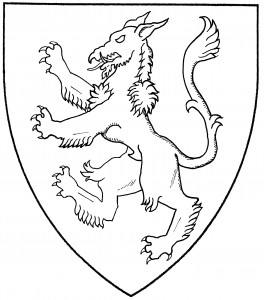The tyger is an heraldic monster, described as incredibly swift and deceitful; its body is much like that of the wolf, but it has a crest of tufts on the back of its neck, and a tusk pointing down from its nose. Medieval legend asserts that to escape a pursuing tyger, one must throw a mirror before it, so that it will be entranced by its reflection; indeed, the tyger in the arms of Sybell, 1531, is in just such a pose [Dennys 144]. The illustration shows a tyger rampant.
When blazoned a “natural tiger” or “Bengal tiger”, the term denotes a natural beast, the great cat Felis tigris: like a maneless lion, but with stripes on its coat. When blazoned “proper”, its coat is tawny, and the stripes black; this naturalistic coloring is no longer permitted in Society armory, but standard heraldic tinctures (e.g., “a Bengal tiger Or marked sable”) may still be used. The use of a Bengal tiger is considered a step from period practice. The illustration shows a Bengal tiger rampant.
The King of the East bears as a badge: A tyger passant azure.
Alia la rousse bears: Gules, in pale two tygers passant argent.
Sean Fitzwallace bears: Gules, a Bengal tiger rampant guardant proper within a bordure counter-compony argent and azure.

